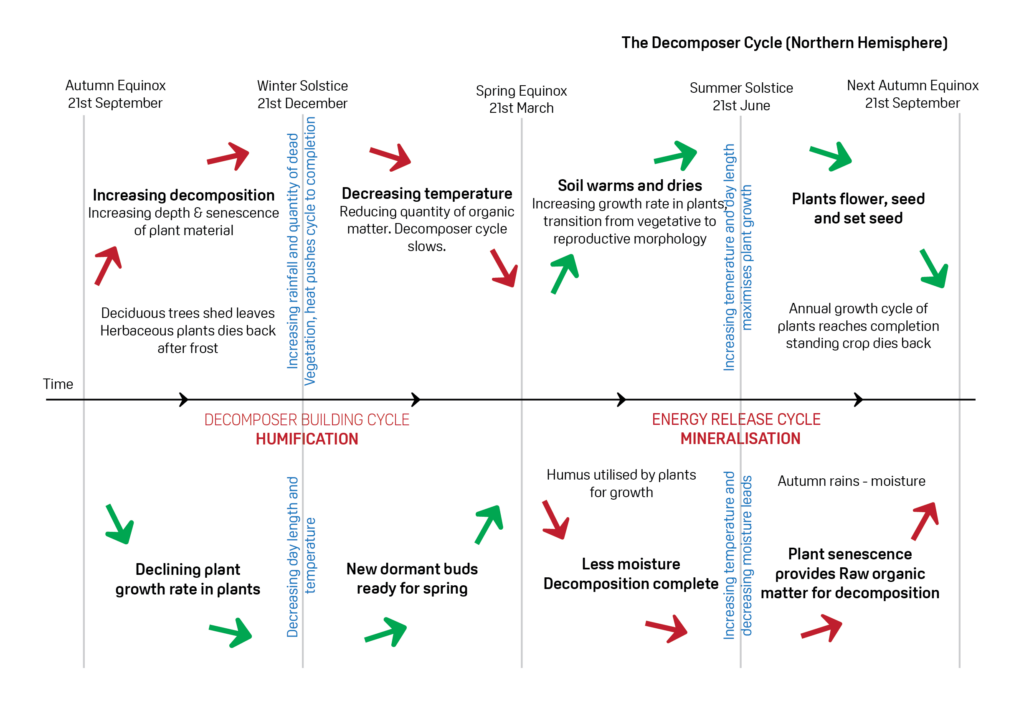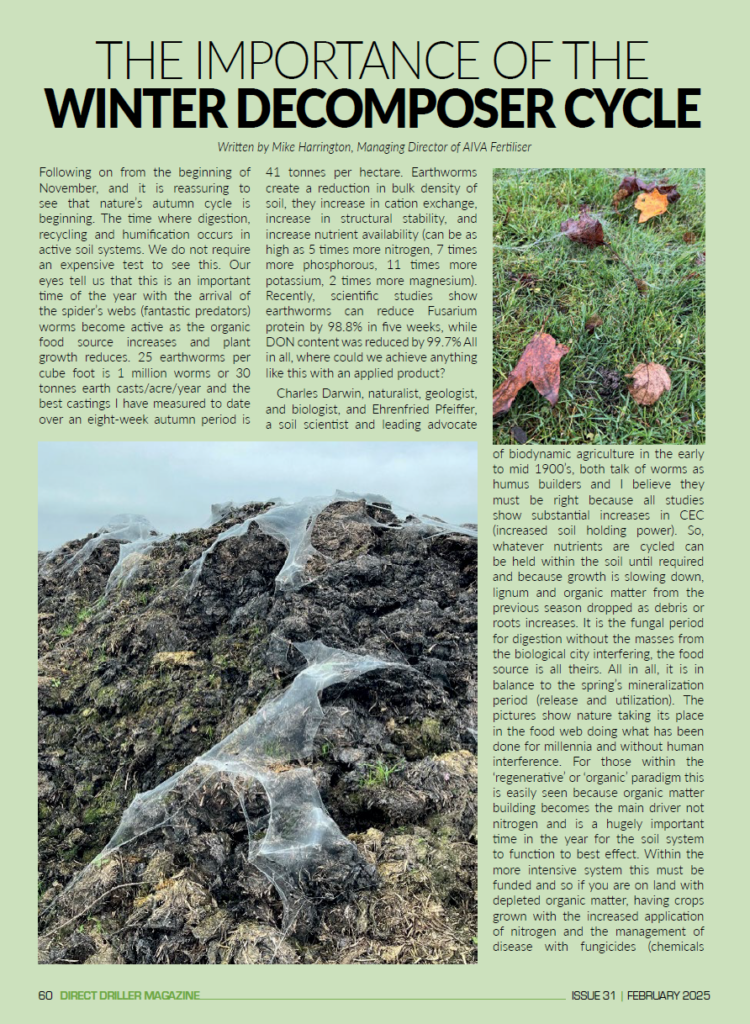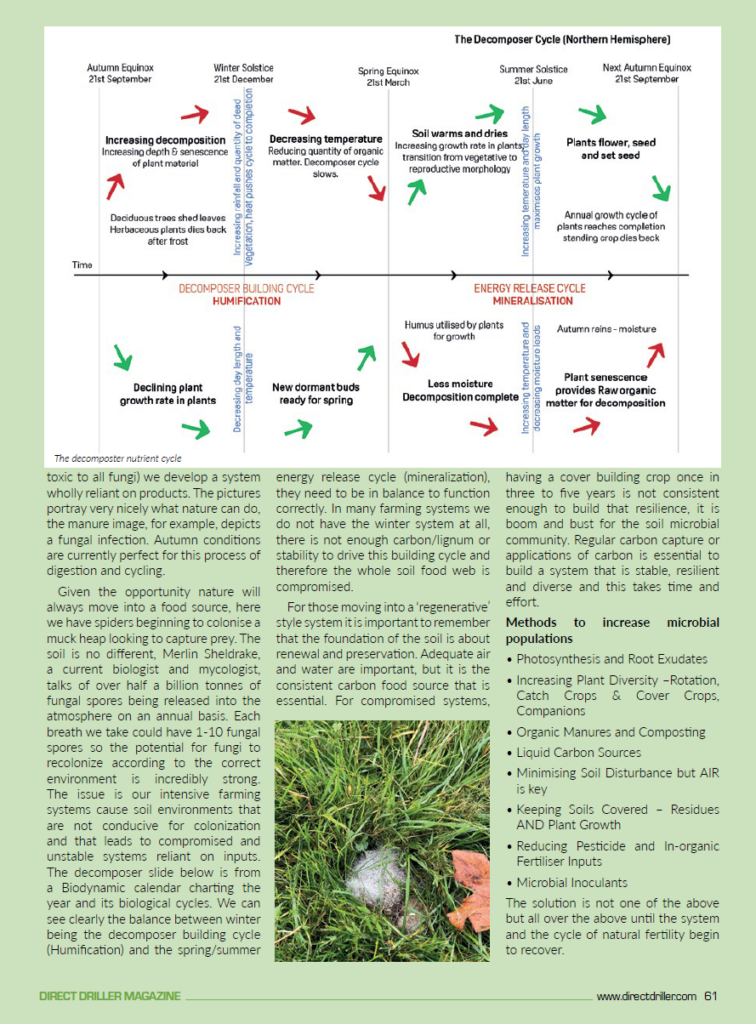Written by Mike Harrington, Managing Director of AIVA Fertiliser
Following on from the beginning of November, and it is reassuring to see that nature’s autumn cycle is beginning. The time where digestion, recycling and humification occurs in active soil systems. We do not require an expensive test to see this. Our eyes tell us that this is an important time of the year with the arrival of the spider’s webs (fantastic predators) worms become active as the organic food source increases and plant growth reduces. 25 earthworms per cube foot is 1 million worms or 30 tonnes earth casts/acre/year and the best castings I have measured to date over an eight-week autumn period is 41 tonnes per hectare. Earthworms create a reduction in bulk density of soil, they increase in cation exchange, increase in structural stability, and increase nutrient availability (can be as high as 5 times more nitrogen, 7 times more phosphorous, 11 times more potassium, 2 times more magnesium). Recently, scientific studies show earthworms can reduce Fusarium protein by 98.8% in five weeks, while DON content was reduced by 99.7% All in all, where could we achieve anything like this with an applied product?
Charles Darwin, naturalist, geologist, and biologist, and Ehrenfried Pfeiffer, a soil scientist and leading advocate of biodynamic agriculture in the early to mid 1900’s, both talk of worms as humus builders and I believe they must be right because all studies show substantial increases in CEC (increased soil holding power). So, whatever nutrients are cycled can be held within the soil until required and because growth is slowing down, lignum and organic matter from the previous season dropped as debris or roots increases. It is the fungal period for digestion without the masses from the biological city interfering, the food source is all theirs. All in all, it is in balance to the spring’s mineralization period (release and utilization). The pictures show nature taking its place in the food web doing what has been done for millennia and without human interference. For those within the ‘regenerative’ or ‘organic’ paradigm this is easily seen because organic matter building becomes the main driver not nitrogen and is a hugely important time in the year for the soil system to function to best effect. Within the more intensive system this must be funded and so if you are on land with depleted organic matter, having crops grown with the increased application of nitrogen and the management of disease with fungicides (chemicals toxic to all fungi) we develop a system wholly reliant on products. The pictures portray very nicely what nature can do, the manure image, for example, depicts a fungal infection. Autumn conditions are currently perfect for this process of digestion and cycling.



Given the opportunity nature will always move into a food source, here we have spiders beginning to colonise a muck heap looking to capture prey. The soil is no different, Merlin Sheldrake, a current biologist and mycologist, talks of over half a billion tonnes of fungal spores being released into the atmosphere on an annual basis. Each breath we take could have 1-10 fungal spores so the potential for fungi to recolonize according to the correct environment is incredibly strong. The issue is our intensive farming systems cause soil environments that are not conducive for colonization and that leads to compromised and unstable systems reliant on inputs. The decomposer slide below is from a Biodynamic calendar charting the year and its biological cycles. We can see clearly the balance between winter being the decomposer building cycle (Humification) and the spring/summer energy release cycle (mineralization), they need to be in balance to function correctly. In many farming systems we do not have the winter system at all, there is not enough carbon/lignum or stability to drive this building cycle and therefore the whole soil food web is compromised.

For those moving into a ‘regenerative’ style system it is important to remember that the foundation of the soil is about renewal and preservation. Adequate air and water are important, but it is the consistent carbon food source that is essential. For compromised systems, having a cover building crop once in three to five years is not consistent enough to build that resilience, it is boom and bust for the soil microbial community. Regular carbon capture or applications of carbon is essential to build a system that is stable, resilient and diverse and this takes time and effort.
Methods to increase microbial populations
- Photosynthesis and Root Exudates
- Increasing Plant Diversity –Rotation, Catch Crops & Cover Crops, Companions
- Organic Manures and Composting
- Liquid Carbon Sources
- Minimising Soil Disturbance but AIR is key
- Keeping Soils Covered – Residues AND Plant Growth
- Reducing Pesticide and In-organic Fertiliser Inputs
- Microbial Inoculants
The solution is not one of the above but all over the above until the system and the cycle of natural fertility begin to recover.

